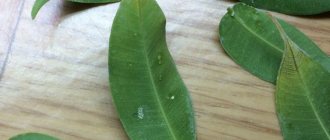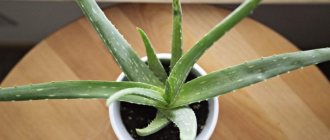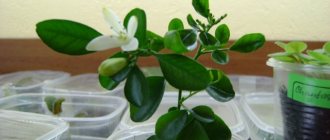Among the many decorative deciduous crops, ficus stands out for its unpretentiousness and diversity of species. These plants are grown in the form of a tree, in the form of a banyan tree, braiding the roots into whimsical patterns, or form a bonsai. The culture easily tolerates conditions that are not the most favorable for itself, but still the best specimens grow only with proper handling. Let's understand the intricacies of caring for ficus benjamina at home.
How to propagate ficus benjamina at home
I bought my first Benjamin after a major renovation in my apartment.
Everywhere there was a smell of either wallpaper, or glue, or laminate flooring, and the children were about to return from their grandmother. A friend recommended this particular plant - they say that ficus perfectly absorbs even formaldehyde, making the air cleaner. I bought the biggest one I saw in the store and placed it in the nursery. The smells really began to disappear. And when my sister started renovations, I “made” five pieces for her from my ficus in advance, for post-renovation “disinfection” of the space.
This beauty can be propagated in several ways.
The main thing is to have time to do this in the spring or in the first month of summer. These days, both the crown and the root system are growing especially actively, that is, the plant itself will “help” you.
Well, and of course, do not forget that you need to take cuttings only from a healthy plant, because after “circumcision” the ficus must have the strength to recover.
There are three ways to grow ficus (except cloning - but this is an industrial method that cannot be repeated at home).
By cuttings (so-called vegetative propagation)
This is the most popular way to grow a new ficus.
Important points when choosing a cutting:
- It is better to take green twigs rather than brown (woody) ones. You can take semi-lignified ones.
- They must be cut with a sharp knife (if you use dull scissors, they will only crumple the tissue, which is why the cutting may not germinate). It is customary to cut a branch at an angle.
- Don't cut too large a cutting. If it starts to sprout roots, they will turn out small and will not be able to “feed” a large cutting. A good size is 2-5 internodes, that is, no larger than 10 cm.
- You can also remove some of the leaves from the cuttings. Some people “kick off” the lower ones, others the largest ones. The essence of this procedure: this way the plant will evaporate less moisture, and the soil underneath will remain moist longer.
Many crops are propagated by leaf cuttings. But the leaves of the ficus benjamina do not let go of their roots.
Our next steps:
- Good soil for rooting: peat + sand, or coconut fiber, or wet sphagnum moss, or vermiculite (perlite). When caring for the “baby,” you can water it not just with water, but with a solution of a substance that helps plants take root.
- Before you start rooting, you need to wash off the sticky (milky) sap of the ficus, otherwise it will release from the “wound” on the cutting and begin to slow down rooting. This is done both under the tap and in a glass, in which the sprig is placed for 2 hours, then the water is changed - and so on several times (until you see that the juice no longer flows out). After this procedure, let the cutting lie on the table for several hours to dry.
- You can keep the cutting in fresh water longer (even several days or weeks, until the branch begins to grow roots - it all depends on the specific variety; variegated ficuses, such as Starlight, generally take up to a month to take root).
- The cutting itself takes root “with a creak”; it needs to be helped by organizing a small greenhouse. Simply put, tie the pot together with the cuttings in a transparent bag, covering it with a glass container. Yes, it’s not entirely aesthetically pleasing, but it’s cheap, reliable and practical.
By the way, a greenhouse can also be made from cut plastic bottles. It's more convenient than a package and costs pennies. Such a greenhouse looks like this:
The greenhouse can be kept on a warm heating pad or radiator (but not too hot, otherwise the soil will dry out too quickly, leaving the cuttings no chance to survive). Water the substrate from time to time (you can simply spray it), and ventilate the cuttings.
If you have rooted cuttings of many crops, then you know that a sign that the branch has taken root is new growing leaves. Ficus is a capricious “creature” and may not grow for some time, even after taking root.
But look at the leaves that were on it initially: if 10 days have passed after sticking the “stick” into the ground, and the leaves are still there and still turning green, everything worked out for you, the cutting has taken root.
When you see new leaves, do not remove the greenhouse immediately. It is necessary to gradually accustom the young plant to fresh air and normal room temperature, and only then release the plant “to freedom.”
To make the cutting take root faster, you can use modern floriculture chemistry. In this video they talk about Kornevin, and also show the real results of this drug. Well, what can I say - he definitely inspires trust!
But do not forget that products like “Kornevin” are considered moderately dangerous. Therefore, do not work with them in the kitchen or living room, wear gloves, and after use, wash and put your clothes in the wash.
Seeds
This method is very problematic, although I will not say that it is not feasible. It is often remembered by breeders who develop new hybrids and varieties.
If you nevertheless bought a bag of seeds, you need to proceed as follows:
- Soak the seeds in a solution of fungicide and growth stimulator.
- Sow on top of light, moist soil. Peat + sand will do.
- Make a small greenhouse over the seeds. It should be 26-30 degrees inside. You can use the same bag, a piece of glass, or a plastic bottle. Or, if you are very keen on indoor plant growing, you can look for special beautiful greenhouses for flowers in Ikea - they sell a set of as many as three pieces of different sizes.
- When the sprouts sprout, make sure that they stand in the light all the time, otherwise they will stretch out.
Lateral layering
This method is remembered in several cases: all the shoots on the plant have become woody (this Benjamin is reluctant to grow new branches), or you are growing a bonsai.
Everything is done like this:
- On a brown branch with thick bark, this very bark (without touching the inside, that is, the wood) is cut into a ring.
- The bare “body” of the ficus is treated with “Kornevin”.
- After this, the incision is wrapped with wet (lightly) sphagnum moss.
- Next, a ball of film is created. Thread, wire or electrical tape will help to fix it on the tree. The roots should appear 3-4 weeks later.
- When you see that the roots are visible through the film, the film and moss need to be removed, and the top of the ficus along with the young roots should be cut off.
- The cut area on both the old ficus and the new tree is rubbed with crushed charcoal (you can use pharmacy activated one) so that the plant does not get sick.
- Plant the young tree in light, nutritious soil.
You can see a positive example of such reproduction in this video. Yes, here the rubber-bearing ficus is used as a “model”, however, you need to do the same with Benjamin:
Source: https://sornyakov.net/komnatnye/fikus-bendzhamina-razmnozhenie.html
Top dressing
Use mineral (Epin at a dosage of 1 ml per 5 liters of water) and organic (manure at the rate of 1 g per 1 liter of water, bird droppings - 5 g per 1 liter of water) fertilizer for ficus or ornamental foliage plants 2 times a month from March to September.
It is advisable to alternate them. You can not only sprinkle the soil with fertilizer, but also add it to the water for spraying the leaves and generously moisten both the foliage and the trunk.
In winter, give the plant a break from fertilizers to provide it with an artificial dormancy period. It is also better to refrain from fertilizing for a month after transplantation.
In addition to chemicals, you can also use folk remedies: dilute 1 tbsp. sugar in 1 liter of water and use it for watering (it is enough to apply this fertilizer twice a season).
Proper transplantation and propagation of ficus benjamina
It is difficult to imagine a home without indoor plants. They bring comfort and a special atmosphere . Ficus Benjamin is considered one of the beautiful and useful plants, the propagation of which is a whole science. In order for it to please you with a well-groomed, healthy appearance, it should be replanted regularly. To do this, it is important to know how to properly propagate and replant the plant.
Ficus is propagated in order to beautify your home and purify the air , because the plant is capable of absorbing harmful impurities from the atmosphere. Many people breed the flower for sale, because it is in demand due to its pleasant appearance and easy care.
Reproduction methods: how to plant and grow a good large flower
Under natural conditions, ficus benjamina reproduces by seeds and. After flowering and pollination, seeds set and ripen, fall to the ground and germinate. This is how a new plant appears.
At home , the simplest methods to propagate a flower are:
- cuttings;
- propagation from leaves ;
- using layering - horizontal and air.
Sowing seeds is not an easy task. To do this, you should buy seeds in specialized stores. To speed up germination, they are soaked in a solution of stimulants (Kornevin, Zircon, Novosil). The purpose of the procedure is disinfection and increased germination .
Next, sowing is done in loose soil, shallowly, 0.5 cm.
To properly propagate and root a flower, it is important to create a comfortable temperature and humidity —greenhouse conditions. To do this, cover the container with glass or film.
Proper care of your ficus is the key to the health of your flower!
Ventilation is carried out periodically . Watering - in the form of spraying, every other day. To speed up germination, you can organize additional lighting. The average seed hatching time is 20-30 days.
You can plant them in individual containers when the seedlings grow to 5-6 cm.
Cuttings of homemade Benjamin: propagated by cuttings
Cuttings are a simple and effective propagation method. Cuttings no longer than 12-15 cm are cut from the upper shoots. It is better to cut them at an angle - oblique cut . This will speed up root formation. You can root cuttings in water or soil.
Before rooting, it is necessary to soak the planting material. At least 2 hours - this will wash away the milky juice and prevent rotting.
How to take cuttings step by step :
- cut and soak the cuttings;
- dip the bottom part in Kornevin ;
- place in an opaque container with settled water ;
- or plant in a mixture of sand, peat and nutrient soil;
- organize a temperature of 25-27 degrees and high humidity.
Ficus cuttings
If the rules are followed correctly, the root system will grow and take root in 14-20 days .
How can a ficus reproduce from a leaf?
Leaf propagation is not such a popular method , but many people use it. You need to choose a healthy, not old, but not the top leaf. It is better to take from the middle part of the stem. It is necessary to cut off part of the trunk . Planting is done in light soil - a mixture of sand, vermiculite and peat.
Moreover, the leaf should be deepened throughout the cuttings. Create greenhouse conditions and wait. How does watering occur? In the form of spraying, once every 3-4 days. Ventilation - once a day . Rooting occurs within a month.
Reproduction of ficus from leaves
Layering: another way to propagate ficus using a twig
Reproduction by layering - aerial and horizontal - allows you to get a formed plant in a short time . The air layering method is not complicated, but it does require some skill:
- you need to choose healthy escape ;
- remove a few leaves;
- Using a sharp, clean knife, make a couple of shallow cuts on the bark, the length between them is 2-3 cm;
- remove the bark in this place ;
- treat the area Kornevin powder ;
- wrap in moistened sphagnum moss ;
- wrap with film and tie at both ends;
- After the roots develop, cut the cuttings and plant them in the ground.
You must constantly ensure that the moss is wet. If it dries out, the process will be delayed, or the shoot will die.
Reproduction by horizontal layering is suitable for tricks with flexible branches.
How to do it correctly:
- choose that is not too old ;
- remove a few leaves in the right place;
- bend the branch to the ground in the form of an arc, slightly deepen it ;
- secure with a wooden stick, wire, or piece of expanded clay;
- carry out regular watering ;
- After the root system has formed, cut off the rooted shoot from the whole plant.
Ficus transplant: how to transplant a flower
The plant needs periodic replanting. This is necessary for further growth and renewal of the soil, which is depleted. There are signs that indicate the need for the procedure :
- the roots are visible from the drainage holes of the pot;
- the soil dries quickly after watering ;
- a tangle of roots is visible on the soil surface
Choose a pot commensurate with the plant
How to replant step by step
| Step-by-step instructions for replanting a ficus | |
| Stage 1 | prepare a new pot , soil mixture |
| Stage 2 | Water the ficus generously, wait until the soil is completely saturated |
| Stage 3 | get the plant along with the earthen lump |
| Stage 4 | Place drainage at the bottom of the new container |
| Stage 5 | transfer the plant to a container and add fresh soil |
| Stage 6 | with settled water |
The frequency of replanting depends on the age of the flower . If it is less than 4 years old, it must be replanted annually. If more than 4 years - once every couple of years. When the plant has grown to a decent size, you can replace the top layer of soil with a new, fresh one.
It is better to replant in early spring, in early to mid-March, so the ficus will take root faster and begin to grow. In autumn and summer it is better not to do this - the foliage may wake up.
When transplanting a ficus, step-by-step is important
Planting isn't everything.
After the plant is replanted, you need to put it in its original place; there is no need to fertilize it for 1-2 weeks, let it adapt to the new soil.
You can spray no more than a couple of times a day , in winter once every 2 days. After transshipment leaves may fall off ; this is a normal process; the crown will recover in the future.
Choosing a flower pot: which one is needed for planting
ceramic flowerpots that are wide and not too deep will be optimal Plastic will also work, the main thing is to focus on the condition of the plant. Drainage holes at the bottom are required; stagnation of water leads to rotting of the roots.
A pallet is also needed . With each subsequent transshipment, the flowerpot is needed 3 cm larger than the previous one. For large specimens, wood masonry is suitable.
Large-leaved ficus: proper soil, lighting, humidity
The soil for large-leaved ficus should be:
- fertile;
- slightly acidic;
- loose and light.
It’s easier to buy a special soil mixture at a flower shop, or a universal soil. You can prepare the mixture yourself. Ideal composition to grow ficus:
- turf soil - 1 part;
- leaf soil - 1 part;
- peat - 1 part;
- sand - 1 part.
Everything is thoroughly mixed and a nutritious neutral soil is obtained.
The soil for ficus needs to be properly prepared.
Air humidity is needed within 60-70% , not lower. Therefore, the flower should be sprayed with clean filtered water . If you ignore this rule, especially in summer, the plant will begin to turn yellow and shed its leaves.
Another way to maintain humidity is to shower . Covering the soil with the flowerpot with a bag, wash the leaves in the shower with warm water. After the procedure, the plant will be transformed.
Bright lighting is required, but direct sunlight is dangerous - it will burn the leaves. It is optimal to place the plant on the eastern windowsill. Darkening will affect the appearance - the leaves will lose their bright color, growth will slow down.
Proper lighting for ficus in the house
Ficus is one of the plants that is easy to care for. Regular watering, fertilizing, proper placement in the apartment, replanting once every year or two - the rules are simple. If they are followed, the plant will delight you for many years with its elegance and lush green crown.
Source: https://proklumbu.com/komnatnue/fikus/razmnozhenie.html
Errors in care and their correction
| Manifestation | Cause | Correction |
| Pale foliage. | Little light. | Place in a well-lit place. |
| Pale and lethargic leaves. | Excessive watering. | Do not water or transplant into another pot. |
| Reset of leaves. | This is the norm in autumn. If the leaves fall strongly, then the flower is most likely in a draft or the temperature is too high for it. | Remove to another place and adjust the temperature. |
Methods for propagating ficus benjamina at home
Flower growers often grow a plant such as ficus benjamina in their homes. This flower is distinguished by its unique unpretentiousness along with a rather spectacular appearance. Growing ficus is not difficult, and caring for it is simple. Let's find out how Ficus Benjamin is propagated at home and get acquainted with all the options for this procedure.
Methods
Ficus benjamina is a unique plant that has the ability to quickly and efficiently purify indoor air. From the environment, the flower absorbs chemical compounds harmful to people: phenol, benzene, ethylene and others. After absorption, the smart plant breaks down these harmful substances in its body into amino acids and natural sugars.
To propagate a plant at home, you can use the following methods:
- seeds;
- cuttings;
- layering.
Let us immediately note that it is not customary to propagate this plant by seeds at home - the process is too long and complicated. Most gardeners choose the cutting method; sometimes layering is also used. Next, we will consider all of the listed methods in detail.
Cuttings
This is the most popular option in indoor floriculture. Propagation by cuttings does not require much time and is not too troublesome compared to other methods. In addition, cuttings from ficus in most cases leads to a successful result.
What time to choose
It is recommended to take cuttings from Ficus Benjamin in the spring. Early summer is also suitable - during this period the flower grows most actively. The choice of the spring-summer period is also justified by the fact that there is a lot of time before the cold weather: the ficus will have time to take root and strengthen properly.
Preparation of cuttings
The cutting must be cut from a healthy mother plant: usually the apical part is taken. The shoot size is 15 cm, its base should be semi-lignified. The cuttings should have from 4 to 6 leaves - fully expanded. A completely lignified cutting will not work, as it will not be able to produce roots: such a shoot can only be propagated by layering.
If there is no possibility or desire to touch the top of the donor plant, you can also acquire cuttings from a side shoot. The main thing is that the shoot has a leaf and a full-fledged axillary bud.
When cut, a milky juice is released, which must be blotted off immediately with a napkin. Then you need to cut off the leaves located below - when soaked in water they run the risk of rotting. Cuts must be made obliquely.
Important: cut cuttings only with a knife and not with scissors, as scissors can make the cut fringed, unsuitable for rooting, and prone to rotting.
Rooting
The roots of cuttings can be grown both in water and directly in the soil. If the first method is chosen, the cut part of the shoot is immersed by one third in settled water at room temperature. To prevent rotting from occurring, it is recommended to add an activated carbon tablet to the water. Place a jar of water on a well-lit windowsill, adding new water as it evaporates.
Choose an opaque container, as otherwise microorganisms will quickly begin to multiply in the water.
Experienced gardeners, in order to control the process of root regrowth, place the ficus in a small transparent container, which in turn is placed in a large opaque one, also filled with water.
The cutting is ready for rooting, the roots of which have grown by about 3 cm. This usually happens after a month.
Although root regrowth in water is practically guaranteed, when planted directly into the ground, the ficus root system turns out to be much stronger and more resilient. But the rooting itself occurs a little less often.
To root the cuttings in the ground, take a mixture consisting of:
- peat;
- ground charcoal;
- river sand.
Or you can purchase a ready-made substrate for ficus, sold in a flower shop. It is important that the soil is moist, but in moderation.
Being in water or in the ground, after 2-3 weeks under favorable conditions, the cutting takes root. To make the shoot take root faster, you can make several cuts on the lower part of the bark - thanks to such cuts, the plant reproduces much more readily, quickly releasing roots.
Make sure that the lower point of growth of the cutting is underground and not on its surface. And if you want roots to appear faster, build a mini-greenhouse by covering the top of the cutting with a plastic bag. From time to time, the polyethylene must be unwound so that the cutting can “breathe.”
Landing in a permanent place
After the roots have grown, the ficus seedling must be placed in a container with permeable, loose and nutritious soil. After planting, it is better to cover the plant with polyethylene for the first few days to create more favorable conditions for its adaptation. Remove the bag when new leaves appear on the seedling, indicating that the plant has taken root and the cuttings have been successfully completed.
Important: if the roots have grown long and become too long, it is recommended to cut them to about 3 cm before planting.
Reproduction by layering
This method is more complicated than the previous one, but is also quite applicable. Layerings are called ordinary aerial roots. The method is indispensable if the ficus is old, completely lignified and not suitable for cuttings.
On the lignified shoot of the mother plant, you need to cut the bark in the shape of a ring (see photo). Cut carefully to avoid damaging the wood too deeply.
The bark-free area of the plant is treated with a root stimulator and covered with peat, moss or peat soil mixture soaked in water. All this is fixed with a waterproof transparent film and secured firmly.
Moisten the moss/peat periodically to create favorable conditions for root germination. Usually, two months pass from the moment the bark is cut until the shoot is ready for planting.
Sprouted roots can be seen directly through the film. When this happens, the shoot with roots is separated from the mother plant and planted in a separate pot. Don't forget to treat the cut on the donor plant with activated charcoal or charcoal. It can also be treated with garden varnish.
Interesting: the method of propagating ficus by layering is used by bonsai specialists to obtain miniature trees of unusual shapes.
Seed propagation
This method is used less often than others, since it is quite tedious and very long.
It is usually customary to propagate ficus seeds only in breeding stations for scientific purposes - there is no need for such troubles at home. However, if you have free time and are determined to try growing ficus from seed, we will give some important instructions on this matter.
Before placing in the ground, the seeds must be treated with a growth stimulant - this way they will sprout more readily and quickly. Don’t forget about fungicides - it is important to protect plants from damage by pests and diseases.
Seeds are sown in light, nutritious and well-moistened soil. The container is placed in a warm place and covered with polyethylene on top. Thus, with constant ventilation and spraying of the soil, you should wait until the seeds germinate.
How to care
Let's find out what kind of care needs to be provided to the young Ficus Benjamin.
In order for the plant to please with its active development and healthy appearance, maintain a warm temperature in the room: the range should be from +25 to +28 degrees. In winter, +15 degrees will be enough. Ficus should be grown in a place inaccessible to the penetration of aggressive direct rays of the sun.
Regular watering must be ensured; drought and flooding of the soil should not be allowed. In addition to watering, you should also spray the young plant with a spray bottle - especially if it is summer heat outside or the air in the apartment is dry due to working batteries. But moisten the soil only after its top layer has noticeably dried out, not before.
Periodically wipe the ficus leaves with a damp cloth/sponge, since dust cannot be removed by spraying. Once a week, it is advisable to bathe the ficus in the shower: this procedure will simultaneously moisturize the plant and wash away dust and dirt from its leaves.
An important aspect of care is feeding the plant. Apply fertilizers according to the standard scheme, using complex compositions for ficus plants.
The plant will also need replanting. This procedure is usually carried out in the spring, each time choosing a slightly larger pot for the plant.
The plant is susceptible to pest attacks. Typically, misfortunes occur due to non-compliance with care requirements, as well as due to too dry air in the room. If the air is dry, ficus often acquires the following parasites:
- spider mite;
- thrips;
- scale insects, etc.
To avoid infection, spray the plant regularly.
Adviсe
After cutting from an open wound on a shoot, milky sap can flow for a very long time. To stop this “bleeding,” be sure to sprinkle the cut area with coal or treat it with garden pitch or wax. If none of the listed materials are at hand, you can stop the flow of juice with a cotton swab.
You cannot place the pot with the plant in a shaded place - ficus benjamina should be grown in abundant, diffused light. If there is not enough lighting for the flower, its trunk and branches will stretch out, giving the ficus an unaesthetic, sloppy appearance.
It is not recommended to frequently move the pot with the plant from place to place. Ficus is a true conservative and has difficulty getting used to new conditions. Ideally, immediately after planting, you need to place the pot in the place where it will now stand all the time.
Along with changing place of residence, ficus cannot tolerate stress. When growing this flower, sudden temperature changes and alternating too bright and dark lighting should not be allowed. Due to the experiences associated with such changes, the ficus foliage may begin to turn yellow and then fall off.
So, we got acquainted with methods of propagation at home of ficus benjamina.
The simplest and most effective option is cuttings: with the help of this simple method, novice gardeners can propagate ficus.
Well, if you want to experiment, you can try seed propagation - who knows, you might be able to breed a plant species unknown to science. The tips from the article will be useful to you in any case.
Source: https://rastenia.info/tsvetyi/fikus/kak-razmnozhit-fk.html
Varieties
Ficus plants have been grown at home for several centuries, and botanists regularly develop new species. They differ in leaf shape, color and maintenance conditions:
- Exotic. Found only on the islands of Bali. The leaves have a glossy surface and a rich green color, they are densely located to each other. The plant is considered decorative, but to grow it you need a consistently warm room.
- Curley. This species evolved from several other species. Ficus grows quickly and loses its shape, so it is trimmed regularly. Almost all of its leaves are different from each other: there are light, dark, straight, and patterned.
- Kinky. Ficus does not exceed 40 cm in height, and each of its leaves is 4 cm. They are mostly dark green, but have a white frame. Young plants look more like a flower, but over time they will stretch out if there is enough sunlight. Its crown is periodically trimmed to give it an interesting shape.
- Daniel. Outwardly, it is almost no different from the first named variety, but in this case the ficus has more matte leaves with a sharp tip and a rich green color. This plant is considered one of the most unpretentious; it feels comfortable even in a dark apartment. In one season, the ficus grows by 30 cm; some people adjust it or leave it in this form in order to grow it across the entire wall.
- Braft. All its leaves are approximately the same color, there is a shiny layer on top, they grow up to 8 cm in length. The leaves of a young plant have a yellow edge, which fades over time. Age is determined by this criterion if ficus is purchased secondhand. In summer it grows faster than others.
- Starlight. One of the most unusual varieties, which is distinguished by variegated leaves. They are slightly curved and shaped like a small boat. The greens always have white (sometimes cream) spots and stripes. Sometimes there are so many of them that the greenery is not visible at all. The plant is grown only in warm regions, as it is susceptible to sudden changes.
- Natasha. The variety grows quite slowly, but the foliage is very dense, rich green in color with small shoots. As they grow, the leaves become darker. Such a plant is regularly sprayed and the foliage is periodically shaken. Some gardeners shape it with wire or string; this variety has very flexible branches, so they do not break.
Ficus benjamina propagation at home
It is believed that ficus brings good luck and cleanses energy, so many housewives would like to acquire this home shrub. Ficus benjamina is very popular now.
This is due to the fact that its trunks can be intertwined into beautiful structures, the crown can be trimmed, and beautiful Bonsai can be created. Very often the question arises of how to grow ficus benjamina at home.
This plant is quite unpretentious and is not difficult to propagate.
Spring and early summer are ideal for propagation, since during this period the plant begins to grow more actively, acquires new branches and foliage, and the root system also grows more rapidly.
There are several ways to propagate Ficus Benjamin:
- Cuttings;
- Reproduction using seeds;
- Microcloning.
At home, the first two types of reproduction are most optimal. Since cloning is used on an industrial scale, or when breeding new varieties of ficus. In this case, gardeners receive an exact copy of the donor plant.
Propagation of Ficus Benjamin by cuttings
If you decide to use this method of plant propagation, you should follow the following algorithm; you can watch the video below for more details:
- We cut branches from the top of the tree 10-15 cm long. We make the cut obliquely. The prepared cuttings should have 2-3 tiers of leaves.
- When you cut the shoot, a white milk will appear; wash it off with water, since dried juice can interfere with the full development of the roots. It is also possible to place the cut cuttings in a container with water; the water must be changed every 2-3 hours until the liquid stops coming out of the cut, then dry it for an hour.
- Place the dried sprout in a jar of water. You need to make sure that the water is at room temperature; in warm water the branch will sprout roots faster.
- We place our plant in a lighted place, but without direct sunlight. We monitor the evaporation of the liquid, add the missing one.
Make sure that the leaves of your future tree do not touch the water, otherwise it may begin to rot. We also recommend adding a tablet of activated carbon to the water, it will also help prevent rotting.
If the conditions are not met, you may get an effect like in the photo below. The sprouts sprouted roots, but they could not be saved, the stalk began to rot, and the leaves fell off (the reasons for the falling leaves can be found here), since they were completely in water.
After the roots in the water have reached about 5 cm in length, it is time to transplant the sprout into a pot for further cultivation. For faster growth, you can treat the lower part of the seedling with a special root stimulator. [ads-pc-1]
We propagate ficus in the ground
There is another way to propagate ficus using cuttings at home - planting cut branches directly into the ground. To do this, you need to select a special mixture of soil that young ficus plants love. If you want to make the mixture yourself, for this we take in equal parts:
- peat soil;
- sand;
- leaf humus.
You can also find packages with the finished substance in stores; they are also suitable for this procedure.
For such rooting, we prepare cuttings in the same way as in the instructions above. After that:
- take the dried cut and sprinkle it with crushed coal;
- we plant the sprout in the ground on one bud;
- cover the plant with a three-liter jar, thus creating a mini greenhouse for it, a plastic bag will also do;
- we water the soil moderately, until it grows it should not be dry, but at the same time you should not make a “swamp”;
- put the pot in a warm place, for example next to a radiator, but no direct sunlight;
- When the branch takes root, you will see new leaves, after which we gradually remove our greenhouse. We start with 15-20 minutes a day so that the tree gets used to the new conditions.
Description
Ficus Benjamina grows both in the wild and at home. In the first case, it reaches a height of 8-10 m, when grown indoors 1.5-2 m. The plant has a dark-colored trunk with streaks. Its branches go down. The leaves are round, with elongated edges, 4-8 cm long, 1.5-4 cm wide, compacted, glossy. Their tone ranges from white and light green to dark. Ficus benjamina has inflorescences in the shape of a ball or a pear, with a diameter of 2 cm. They are pollinated by Bastophages, without which the former simply do not ripen. Planting material is obtained from inflorescences.











